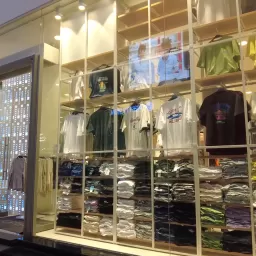Apparel
Apparel refers to clothing, garments, or attire that people wear for various purposes, including protection, modesty, comfort, and style.
 Clothing & Accessories:
The Clothing & Accessories industry encompasses the production, manufacturing, distribution, and retail of apparel, fashion accessories, and related products.
Clothing & Accessories:
The Clothing & Accessories industry encompasses the production, manufacturing, distribution, and retail of apparel, fashion accessories, and related products.
Apparel refers to clothing, garments, or attire that people wear for various purposes, including protection, modesty, comfort, and style. Apparel encompasses a wide range of items designed for different occasions, climates, and cultural preferences. Here are some key aspects to know about apparel:
-
Types of Apparel:
- Casual Wear: Everyday clothing designed for comfort and ease of movement, such as T-shirts, jeans, and sneakers.
- Formal Wear: Dressier clothing suitable for special occasions, events, or professional settings, including suits, dresses, and formal shoes.
- Sportswear: Clothing designed for athletic or sports activities, including activewear, jerseys, and athletic shoes.
- Outerwear: Garments designed to be worn over other clothing for protection from the elements, such as coats, jackets, and sweaters.
- Intimate Apparel: Undergarments, including bras, panties, and lingerie.
- Sleepwear: Clothing worn for sleeping, such as pajamas, nightgowns, and sleep shirts.
- Swimwear: Clothing designed for swimming or lounging by the pool or beach, including swimsuits and cover-ups.
- Workwear: Clothing designed for specific occupational needs, such as uniforms, scrubs, and safety gear.
-
Materials and Fabrics:
- Apparel can be made from a variety of materials, including cotton, polyester, wool, silk, denim, leather, and synthetic blends.
- The choice of material often depends on factors like comfort, durability, and the intended use of the garment.
-
Fashion Trends:
- Apparel is influenced by fashion trends, which can change over time based on cultural, social, and economic factors.
- Fashion designers and brands play a significant role in shaping trends and introducing new styles.
-
Cultural and Regional Variations:
- Different cultures and regions have distinct styles of apparel influenced by traditions, climate, and lifestyle.
- Traditional clothing often reflects cultural identity and is worn during specific ceremonies, festivals, or everyday life.
-
Sustainable and Ethical Fashion:
- There is a growing emphasis on sustainable and ethical practices in the apparel industry. This includes using eco-friendly materials, reducing waste, and promoting fair labor practices.
-
Apparel Industry:
- The global apparel industry involves the design, manufacturing, distribution, and retailing of clothing.
- It is a large and diverse industry with contributions from designers, manufacturers, retailers, and consumers.
-
Online Shopping and E-Commerce:
- The rise of e-commerce has significantly impacted the way people shop for apparel, allowing for convenient online purchases and a global marketplace.
-
Personal Expression:
- Apparel is a form of personal expression, and individual style can vary widely. People often choose clothing that reflects their personality, preferences, and cultural influences.
-
Seasonal Fashion:
- Apparel often follows seasonal trends, with different styles and fabrics being popular in different seasons. For example, lightweight fabrics and bright colors may be favored in summer, while heavier fabrics and darker tones are popular in winter.
-
Customization and Personalization:
- Some consumers seek customized or personalized apparel, such as made-to-order clothing or items with custom prints or embroidery.
-
Technology in Apparel:
- Advances in technology have led to innovations in apparel, including smart fabrics, wearable technology, and sustainable production methods.
Apparel is a dynamic and diverse aspect of human culture, reflecting not only functional needs but also personal identity, cultural values, and societal trends. The clothing we choose to wear can communicate a lot about who we are and how we want to present ourselves to the world.